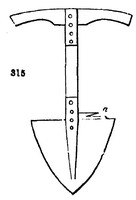1695. The spade (fig. 304.) consists of two parts; the blade, of plate-iron, and the handle, of tough root-cut ash timber, rather longer than the handle of the pick, but generally about two feet nine inches. The blade consists of two parts; the plate, by which the soil is cut and carried, and the tread, which is a piece of strong iron fixed on the upper edge of the blade, to receive the impulse of the foot of the operator. Spades are manufactured of different sizes, and usually with a flat blade; but perforated blades (fig. 305.) are sometimes prized, as cleaning or freeing themselves better from earth in adhesive soils; and semicylindrical blades (fig. 306.), which are used by canal-diggers, are preferred for the same reason, and also as entering the soil easier, because gradually, and in effect as if a flat spade with a pointed or shield-like curved edge were used. Spades with curved edges or pointed blades are easiest to thrust into the earth in hard or stiff soils, and clean themselves better, but they are more apt to leave more untouched parts (baulks) in the bottom of the trench than the common square-mouthed spade. They are the best species for new-ground work, but are not, well adapted for culture. The under-foot spade (fig. 315.) should be made very strong, the shaft, or handle, square, with the angles rounded off, and strongly plated over where it is joined to the cross angle at the top and to the blade below. The blade is about fourteen inches across and twelve inches deep; quite perpendicular, with sharp cutting edges, and a hilt or piece of iron (a) riveted on for the feet. For the stubbing of hedges, taking the top sods off drains, and various uses where strength is wanted, this spade will be found a most powerful instrument.

